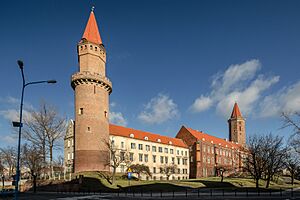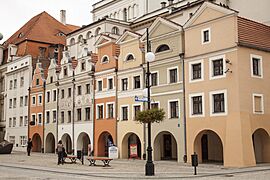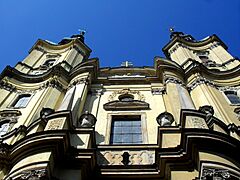Legnica facts for kids
Quick facts for kids
Legnica
|
|||||
|---|---|---|---|---|---|
|
|||||
|
|||||
| Country | |||||
| Voivodeship | |||||
| County | city county | ||||
| First mentioned | 1004 | ||||
| City rights | 1264 | ||||
| Area | |||||
| • Total | 56.29 km2 (21.73 sq mi) | ||||
| Elevation | 113 m (371 ft) | ||||
| Population
(31 December 2021)
|
|||||
| • Total | 97,300 |
||||
| • Density | 1,765/km2 (4,570/sq mi) | ||||
| Time zone | UTC+1 (CET) | ||||
| • Summer (DST) | UTC+2 (CEST) | ||||
| Postal code |
59-200 to 59-220
|
||||
| Area code | +48 76 | ||||
| Car plates | DL | ||||
| Highways | |||||
| National road | |||||
| Website | www.legnica.um.gov.pl | ||||
Legnica is a city in southwestern Poland. It's located in the central part of Lower Silesia, on the Kaczawa River. Legnica is the main city of its county. Since 1992, it has also been the seat of the Diocese of Legnica, a church region. As of 2023, about 97,300 people live in Legnica.
The city was first mentioned in old records from the year 1004. However, people lived here even earlier, around the 7th century. The name "Legnica" appeared in 1149. This was during the time of Bolesław IV the Curly, a powerful Polish duke. Legnica became the home of the dukes of Legnica from 1248 until 1675. It's famous for being the city where the Piast dynasty, a very old Polish ruling family, reigned the longest. They ruled for about 700 years, from the 10th century until 1675. Legnica is also a burial place for some Polish kings and queens.
Legnica is well-known for a huge battle that happened nearby. This was the Battle of Legnica on April 9, 1241. A Christian army, led by the Polish duke Henry II the Pious, fought against the Mongols. The Mongols won the battle, and Henry II was killed.
Today, Legnica is an important center for business, culture, and education in Lower Silesia, just like Wrocław. The city is known for its amazing buildings, which range from very old medieval styles to modern ones. Its old town is well-preserved and includes the Piast Castle, one of the biggest castles in Poland. In 2016, Legnica was ranked as one of the fastest-growing cities in the Silesian region for foreign investments.
Contents
Population
As of December 31, 2012, Legnica had 102,708 people. It is the third-largest city in its region (after Wrocław and Wałbrzych). It's also the 38th largest city in Poland. Legnica is the biggest city in an area rich in copper, with many towns around it.
History
Early Times
Scientists found signs of a bronze workshop in Legnica from around 1000 BC. This means people were making things with bronze here a very long time ago. Later, in the 8th century BC, people from the Lusatian culture lived here. Even Celts and ancient tribes like the Lugii might have lived in this area.
Medieval Poland

Slavic tribes, who are ancestors of Poles, moved into this area in the 8th century. The city was first officially mentioned in records from 1004. But people lived here even earlier, in the 7th century. In 1149, Duke Bolesław IV the Curly built a chapel here. Legnica became an important home for Polish dukes. From 1248 to 1675, it was the main city of a duchy (a small kingdom) ruled by the Piast family.
Legnica became famous for the Battle of Legnica. This battle happened near the city on April 9, 1241. It was during the First Mongol invasion of Poland. The Christian army, led by Polish Duke Henry II the Pious, fought against the Mongols. The Christian army included Poles, German miners, knights, and Czech soldiers. Sadly, the Mongols won, killed Duke Henry, and destroyed his army. After this, the Mongols moved south to join other Mongol armies in Hungary.
Even after the war, the city grew quickly. In 1258, a school was started at St. Peter's church. Around 1278, a Dominican monastery was built by Duke Bolesław II the Horned. He was the only Polish ruler buried in Legnica. By 1300, Legnica had its own city council. Dukes gave the city new trading rights. In 1337, the first water system was built. Between 1327 and 1380, a new Gothic church of Saint Peter was built. This church is now the Cathedral and a famous landmark. City walls were also built in the 14th century. In 1345, the city started making its own coins.
Duchy of Legnica
At the start of the 14th century, Legnica was a very important city in Central Europe. It had about 16,000 people. The city grew even faster after gold was found in the Kaczawa River nearby. But this fast growth didn't last. A huge fire destroyed many wooden buildings. This fire made the city's population shrink and stopped its growth for many years.
Legnica, like other small kingdoms in Silesia, became a part of the Kingdom of Bohemia in the 14th century. It was also part of the Holy Roman Empire. However, local dukes from the Polish Piast dynasty still ruled it. In 1454, people in Legnica rebelled, stopping the city from being directly ruled by Bohemian kings. In 1505, Duke Frederick II of Legnica met with Sigismund I the Old, who would later become the King of Poland.
The Protestant Reformation started in Legnica around 1522, and most people became Lutheran. In 1526, a Protestant university was opened, but it closed a few years later. The first printing press in Legnica was set up in 1528. After 1526, Legnica became part of the Habsburg monarchy of Austria. The city suffered a lot during the Thirty Years' War. In 1633, a terrible plague spread, and in 1634, the Austrian army destroyed parts of the city.
In 1668, Duke Christian of Legnica wanted to become the King of Poland, but he wasn't chosen. In 1676, Legnica came under direct rule of the Habsburg family. This happened after the last Piast duke, George William, died. He was buried in St. John's church in Legnica.
18th and 19th Centuries
In the early 1700s, a special school called the Liegnitz Ritter-Akademie trained young nobles. Legnica was also on one of the main roads connecting Warsaw and Dresden. Polish Kings Augustus II the Strong and Augustus III of Poland often traveled through the city.
In 1742, Legnica became part of the Kingdom of Prussia. This happened after King Frederick the Great defeated Austria in a war. In 1760, during the Seven Years' War, Frederick's army won another battle against the Austrians near Legnica.
During the Napoleonic Wars, Polish soldiers were stationed in Legnica in 1807. In 1813, Prussian forces defeated the French army nearby. After some changes in how Prussia was organized, Legnica became an important administrative center in 1816. In 1871, Legnica became part of the new German Empire. By 1874, it was a major city in Lower Silesia.
The 20th Century
In 1910, most people in Legnica were German. After World War I, Legnica became part of the new Province of Lower Silesia. When the Nazi Party came to power in Germany, Jewish businesses were boycotted in 1933. In 1938, the synagogue was burned down. Polish people in the city were also treated badly. During World War II, many Polish resistance fighters were imprisoned and sentenced to death here. The Germans also set up forced labor camps and prisoner-of-war camps in the city.
After Nazi Germany was defeated in World War II, Legnica and other parts of Silesia were given back to Poland in 1945. Most German residents either left or were moved out. The city was then settled by Poles, including those who had to leave their homes in eastern Poland. Some Greek refugees also settled in Legnica in 1950. The city was renamed Legnica, using its old Polish name.
Legnica was not heavily damaged in World War II. In 1945, it was briefly the capital of the Lower Silesian region. In 1947, a public library opened. A piano factory was started in 1948. From 1951 to 1959, Poland's first copper smelter was built in Legnica. After 1965, many old buildings in the city center were taken down. The city was rebuilt in a more modern style.
From 1945 to 1990, during the Cold War, the main base for Soviet forces in Poland was in Legnica. This greatly affected the city. For many years, Legnica was divided into Polish and Soviet areas. The Soviet areas were closed to the public. In 1956, large protests against the Soviets happened in Legnica. The last Soviet soldiers left the city in 1993.
From 1975 to 1998, Legnica was the capital of the Legnica Voivodeship (a larger administrative region). In 1992, the Roman Catholic Diocese of Legnica was created. In 1997, Pope John Paul II visited the city. Legnica also suffered from a big flood in 1997.
Climate
Legnica has an oceanic climate, which means it has mild winters and warm summers.
Sights
Legnica has many historical buildings from different time periods. Some of the most important sights are:
- The Piast Castle, which was once home to the local dukes.
- The Cathedral of Saints Peter and Paul.
- The Market Square (Rynek) with its old buildings, including:
- The Baroque Old Town Hall (Stary Ratusz).
- The Helena Modrzejewska Theatre.
- The Kamienice Śledziowe ("Herring Houses").
- The Dom Pod Przepiórczym Koszem ("Under the Quail Basket House").
- The former Dominican monastery, where Duke Bolesław II the Horned was buried. Today, it's a high school.
- The Saint John the Baptist Church, which has a special mausoleum for the last Piast dukes.
- The New Town Hall (Nowy Ratusz), where the city government works.
- Saint Mary church.
- The Copper Museum.
- Parts of the medieval city walls, including the Chojnów and Głogów Gates.
- The former Knight Academy, now used for city offices and a part of the Copper Museum.
- The Public Library and archive.
- The City Park (Park Miejski), the oldest and largest park in Legnica.
You can also find a monument to Pope John Paul II and an old postal marker from King Augustus II the Strong (1725) in Legnica.
Economy
In the 1950s and 1960s, the local copper and nickel industries became very important for the area's economy. Legnica is home to factories owned by KGHM Polska Miedź. This company is one of the biggest producers of copper and silver in the world. They have a large copper factory on the edge of town. The Legnica Special Economic Zone was created in 1997 to help businesses grow.
Education
Legnica is a regional center for learning. It has seven universities with about 16,000 students. Some of these include:
- Witelon University of Applied Sciences
- Wrocław University of Technology (a branch campus)
- Foreign Language Teacher Training College in Legnica
- Legnica University of Management
Environment
Legnica is known for its many parks and gardens. It has 700 hectares (about 1,730 acres) of green space. Most of this green space is along the Kaczawa River. The Tarninow district is especially beautiful.
Roads
The A4 motorway is located south of Legnica. Legnica also has a part of national road no 3. An express road, S3, is also planned to be built nearby.
Public Transport
The city has 20 regular bus lines, one circular line, two night lines, and three lines that go to nearby towns. Legnica also has an airport (code EPLE) with a 1600-meter runway. This was once a Soviet air base. As of 2007, it was not in good condition and not used for regular flights.
Sports
- Miedź Legnica – a men's football team. They won the Polish Cup in 1992 and played in Poland's top league (Ekstraklasa) in the 2018–19 season.
- White Eagle Municipal Stadium
Films Made in Legnica
Legnica has been a popular place for filming movies. This is because of its well-preserved Old Town, its closeness to Germany, and lower costs. Some films made here include:
- Przebacz (2005)
- A Woman in Berlin (2007)
- Little Moscow (2008)
- Jack Strong (2014)
Famous People from Legnica
Many notable people were born or lived in Legnica, including:
- Henry II the Pious (1196/1207–1241), a powerful Duke of Poland.
- Witelo (1230–died 1280–1314), a famous philosopher and scientist.
- Bolesław II the Bald (1220–1278), another important Duke of Poland.
- Johann Wilhelm Ritter (1776–1810), a scientist who discovered ultraviolet radiation.
- Leopold Kronecker (1823–1891), a mathematician.
- Paul Löbe (1875–1967), a social democratic politician.
- Anna Dymna (born 1951), a well-known TV, film, and theater actress.
- Tomasz Kot (born 1977), an actor.
- Mariusz Lewandowski (born 1979), a football player.
- Aleksandra Klejnowska (born 1982), a weightlifter.
Sister Cities
Legnica has special partnerships with other cities around the world. These are called "twin towns" or "sister cities." They work together on cultural and educational projects.
Images for kids
See also
 In Spanish: Legnica para niños
In Spanish: Legnica para niños



































